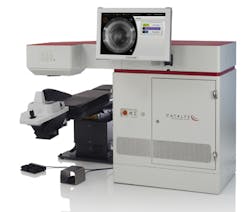OPTICAL COHERENCE TOMOGRAPHY/LASER CATARACT SURGERY: OCT-enabled systems okayed for clinical use
Regulatory bodies including the US Food and Drug Administration (FDA) have recently cleared a number of biophotonics instruments for clinical application. All of the instruments include optical coherence tomography (OCT) technology, and one enables laser surgery as well: Ophthalmic company OptiMedica (Santa Clara, CA) has received FDA clearance of its Catalys Precision Laser System, a laser cataract surgery system that combines a femtosecond laser, integrated OCT imaging, and the company's pattern scanning technology. The system enables cataract surgeons to perform image-guided pre-operative laser lens conditioning, and is FDA-cleared for capsulotomy and lens fragmentation. Clinical study results published in the Journal of Cataract & Refractive Surgery have demonstrated that the Catalys system produces capsulotomies that are within 30 μm of intended size and 80 μm of intended center. Also, laser lens fragmentation with the system reduces cumulative dissipated energy (CDE) during ultrasound phacoemulsification by approximately 40 percent, according to the study.
Bioptigen (Research Triangle Park, NC) recently received regulatory approval to market its handheld Envisu C2000-series ophthalmic spectral-domain OCT imaging systems for clinical use within the European Union and Canada. The handheld scanner is particularly useful for pediatric and non-ambulatory patients; in fact, the US National Institutes of Health (NIH) recently awarded Bioptigen a grant to investigate a handheld device for use with premature and neonatal infants. The FDA is currently reviewing the system for patient use as well.
Finally, NinePoint Medical (Cambridge, MA) has begun a clinical trial for specific application of its Nvision OCT system (which gained FDA clearance in January for endoscopic application) for imaging Barrett's esophagus—a potential precursor to esophageal cancer. The device is the first of its kind to use a circumferential scanning technique and an automatic pullback to generate cross-sectional and longitudinal images simultaneously in real time. Nvision can image beneath the mucosal surface at <10 μm resolution up to a tissue depth of 3 mm, offers a full-field view, and can image circumferentially or helically up to 6 cm in length in <100 s. The company will conduct clinical trials of the system this year and will be scaling up its manufacturing capabilities to support a commercial launch in 2013, according to president and CEO Charles Carignan, MD.
More BioOptics World Current Issue Articles
More BioOptics World Archives Issue Articles

